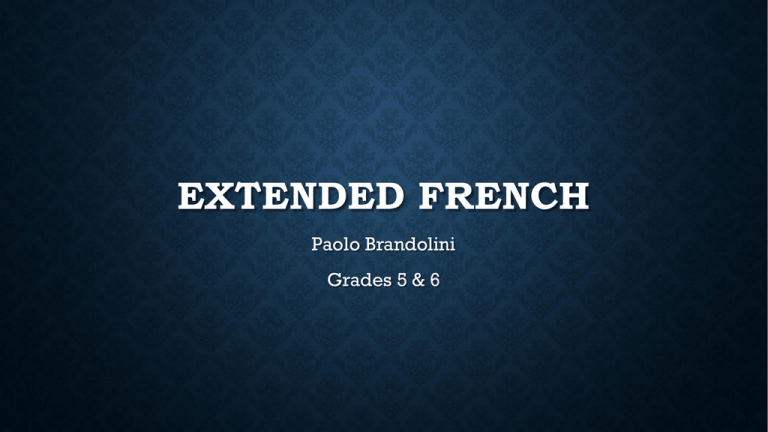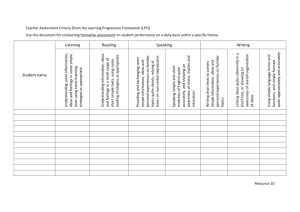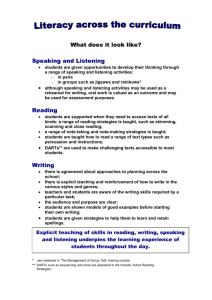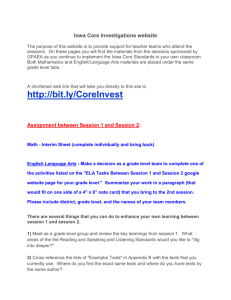Extended French
advertisement

EXTENDED FRENCH Paolo Brandolini Grades 5 & 6 ENDURING IDEAS IN THE FRENCH AS A SECOND LANGUAGE CURRICULUM • By studying a second language, students learn a great deal about interacting effectively with others, because they have to focus closely on what it is they are trying to communicate; what they need others to understand, and why; how their oral or written expression is received and interpreted; and what others are trying to communicate to them, and why. As they learn to exchange information and ideas in another language, they also learn about other ways of thinking, other ways of doing things, and other ways of living – in short, about other people and other cultures. • The French as a second language curriculum emphasizes communicating a message by using knowledge of vocabulary, language conventions, and grammar while taking into consideration the purpose, the audience, and the situation or context. This focus on the sociolinguistic and cultural aspects of language allows students to apply their language knowledge in a variety of real-world situations and contexts. LISTENING, SPEAKING, READING, AND WRITING: INTERCONNECTED BUT DISTINCT • Listening, Speaking, Reading, and Writing: Interconnected but Distinct • In order to develop the skills necessary to become lifelong language learners, students will be given multiple opportunities to: • listen and respond to texts and to others; • speak and interact with others; • read, view, and respond to a variety of texts; • write a variety of texts for many different purposes and audiences. • Listening and speaking skills are the springboards to reading and writing. While the curriculum strikes a balance between these four distinct but interconnected skills, oral communication – listening and speaking – is paramount for second-language acquisition. If students hear it, they can say it. If students can say it, they can read it. And if students can read it, they can write it. CURRICULUM EXPECTATIONS LISTENING • A1. Listening to Understand: determine meaning in a variety of oral French texts, using a range of listening strategies; • A2. Listening to Interact: interpret messages accurately while interacting in French for a variety of purposes and with diverse audiences; SPEAKING • Speaking to Communicate: communicate information and ideas orally in French, using a variety of speaking strategies and age- and grade-appropriate language suited to the purpose and audience; • B2. Speaking to Interact: participate in spoken interactions in French for a variety of purposes and with diverse audiences; READING • Reading Comprehension: determine meaning in a variety of French texts, using a range of reading comprehension strategies; • C2. Purpose, Form, and Style: identify the purpose(s) and characteristics of a variety of adapted and authentic text forms, including fictional, informational, graphic, and media forms; WRITING • Purpose, Audience, and Form: write French texts for different purposes and audiences, using a variety of forms; • D2. The Writing Process: use the stages of the writing process – including prewriting, producing drafts, revising, editing, and publishing – to develop and organize content, clarify ideas and expression, correct errors, and present their written work effectively; READING – GRADE 5 READING – GRADE 6 TRÉSOR JUNIOR SERIES • Multiple opportunities to demonstrate understanding • Use of a variety of teaching strategies which could include cooperative learning, peer practice, word charts, read alouds, think alouds, shared reading, graphic organizers • Variety of assessment opportunities (oral, written, visual) • Use of technology to supplement learning READING STRATEGIES Before • Set goals • Activate prior knowledge • Predict During • Determine main ideas • Make connections • Ask questions • Visualize • Guess • Infer • Connect to grammar rules After • Verify predictions • Summarize, retell • Make conclusions • Verify effectiveness of strategies COMPREHENSION ACTIVITIES Visualization • Through pertinent questioning Story Sequencing Mystery Sentences Picture Story ASSESSMENTS • Cards (oral and written tasks), for summative assessment GUIDED READING • http://www.scholastic.ca/clubs/images/whatisgrl.pdf GR. 5 SOCIAL STUDIES • A. HERITAGE AND IDENTITY: FIRST NATIONS AND EUROPEANS IN NEW FRANCE AND EARLY CANADA • B. PEOPLE AND ENVIRONMENTS: THE ROLE OF GOVERNMENT AND RESPONSIBLE CITIZENSHIP GR.6 SOCIAL STUDIES • A. HERITAGE AND IDENTITY: COMMUNITIES IN CANADA, PAST AND PRESENT • B. PEOPLE AND ENVIRONMENTS: CANADA’S INTERACTIONS WITH THE GLOBAL COMMUNITY SOCIAL STUDIES SUPPLEMENTAL RESOURCES AGENDA • Assists students with organization and time management • Allows parents to be kept abreast of upcoming tests and due dates • Important means of correspondence between teacher and parents EXTRA-CURRICULAR ACTIVITIES CARNAVAL USEFUL WEBSITES • http://www.brainpop.fr/ • http://www3.tfo.org/jeux • http://www.larecre.net/fr/exercices.html • http://www.edu.gov.on.ca/fre/students/links.html • http://passerelle.csf.bc.ca/parents-eleves/ressources/jeux/ • http://www.fslhomeworktoolbox.ca/ • http://voilalearning.com/en/ • http://www.iletaitunehistoire.com/





